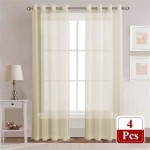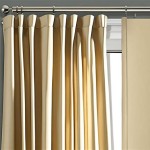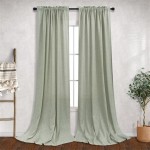Should Curtains Touch the Floor?
The question of whether curtains should touch the floor is a common one among homeowners and interior designers alike. There's no one-size-fits-all answer, as the best choice ultimately depends on personal preference, the style of the room, and the type of curtains being used. However, understanding the advantages and disadvantages of each approach can help you make an informed decision that complements your home's decor and functionality.
The Advantages of Floor-Length Curtains
Floor-length curtains are often considered the more traditional and elegant choice. They create a sense of grandeur and formality, adding a touch of sophistication to any room. Here are some key advantages:
- Enhanced Aesthetics: Floor-length curtains create a sense of height and length, making rooms feel larger and more spacious. They can also help to accentuate the architecture of a room, drawing the eye upwards.
- Improved Privacy: Longer curtains provide greater privacy, especially in rooms with windows that face the street or other nearby homes. They can also help to block out unwanted sunlight or glare.
- Increased Light Control: By extending to the floor, curtains can more effectively block out sunlight and reduce glare, creating a more comfortable and inviting atmosphere.
- Greater Insulation: Longer curtains can help to insulate rooms, reducing heat loss in the winter and blocking out heat in the summer.
- Versatile Styling: Floor-length curtains can be styled in a variety of ways, from simple and minimalist to dramatic and luxurious. They can be paired with different types of hardware, including rods, tracks, and rings.
The Disadvantages of Floor-Length Curtains
While floor-length curtains offer many benefits, they also come with some potential drawbacks. These include:
- Increased Risk of Damage: Curtains that touch the floor are more susceptible to dirt, dust, and stains. They can also be easily snagged or torn, especially if they are made of delicate fabrics.
- Limited Accessibility: Floor-length curtains can make it difficult to access windows and doors, particularly in rooms with limited space.
- Difficult to Clean: Longer curtains can be challenging to clean, especially if they are heavy or have intricate designs.
- Potential Safety Hazard: In areas with high foot traffic, curtains that touch the floor could pose a tripping hazard, especially for children and the elderly.
- Cost: Floor-length curtains often require more fabric than shorter curtains, which can increase their cost.
The Advantages of Curtains That Do Not Touch the Floor
Curtains that do not reach the floor offer a more practical and modern aesthetic. They are often preferred in rooms with limited space or in areas with high foot traffic. Here are some specific advantages:
- Increased Accessibility: Curtains that do not touch the floor provide easy access to windows and doors, making them ideal for rooms with limited space.
- Reduced Risk of Damage: Curtains that do not touch the floor are less likely to be damaged by dirt, dust, or stains. They are also less prone to snags and tears.
- Easier to Clean: Curtains that do not reach the floor are easier to clean and maintain, as they are less likely to accumulate dust and dirt.
- More Modern Aesthetic: Shorter curtains can create a minimalist and contemporary look, adding a touch of style to any room.
- Greater Flexibility: Curtains that do not touch the floor can be easily adjusted, allowing for greater control over light and privacy.
The Disadvantages of Curtains That Do Not Touch the Floor
While shorter curtains offer practical advantages, they may not be the best choice for every room. Here are some potential drawbacks:
- Less Privacy: Shorter curtains provide less privacy than floor-length curtains, especially in rooms with windows that face the street or other nearby homes.
- Reduced Insulation: Curtains that do not reach the floor offer less insulation than longer curtains, potentially leading to greater heat loss in the winter and heat gain in the summer.
- Less Dramatic Effect: Shorter curtains can make rooms feel smaller and less dramatic than floor-length curtains.
- Less Formal Appearance: Curtains that do not reach the floor can create a more casual or informal look, which may not be suitable for all rooms.
Ultimately, the decision of whether to choose floor-length curtains or shorter curtains depends on individual preferences and the specific needs of the room. By weighing the benefits and drawbacks of each option, you can choose the best solution for your home and create a space that you love.

How Close To The Floor Should Your Drapes Hang Ask Expert Style Boston Com Real Estate

When Should Curtains Touch The Floor Quickfit Blinds And

Should Curtains Touch The Floor Guide To Curtain Length

Should Curtains Touch The Floor

How To Choose The Length Of Your Curtains Dummies

Should Curtains Touch The Floor Guide To Curtain Length

Should Curtains Touch The Floor What Interior Designers Do Livingetc

Should Curtains Touch The Floor

What Curtain Drop Do I Need Ada Ina

Choose The Right Curtain Length








